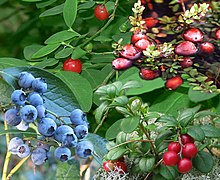Oxycoccus
| Vaccinium | |
|---|---|
 |
|
|
Vaccinium berries, from top left clockwise: Red huckleberries, cranberries, lingonberries and blueberries |
|
| Scientific classification | |
| Kingdom: | Plantae |
| (unranked): | Angiosperms |
| (unranked): | Eudicots |
| (unranked): | Asterids |
| Order: | Ericales |
| Family: | Ericaceae |
| Subfamily: | Vaccinioideae |
| Tribe: | Vaccinieae |
| Genus: |
Vaccinium L. |
| Type species | |
|
Vaccinium uliginosum |
|
| Synonyms | |
|
|
Vaccinium /vækˈsɪniəm/ is a common and widespread genus of shrubs or dwarf shrubs in the heath family. The fruit of many species are eaten by humans and some are of commercial importance, including the cranberry, blueberry, bilberry or whortleberry, lingonberry or cowberry, and huckleberry. Like many other ericaceous plants, they are generally restricted to acidic soils.
The plant structure varies between species – some trail along the ground, some are dwarf shrubs, and some are larger shrubs perhaps 1 to 2 m (3 to 7 ft) tall. The fruit develops from an inferior ovary, and is a berry; it is usually brightly coloured, often being red or bluish with purple juice.
The genus was first described scientifically by Carl Linnaeus in 1753. The name vaccinium was used in classical Latin for a plant, possibly the bilberry or a hyacinth, and may be derived from the Latin bacca, berry, although its ultimate derivation is obscure. It is not the same word as vaccinum "of or pertaining to cows".
...
Wikipedia
